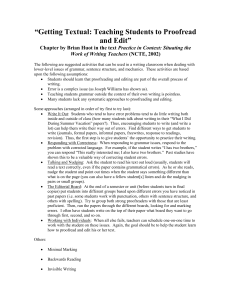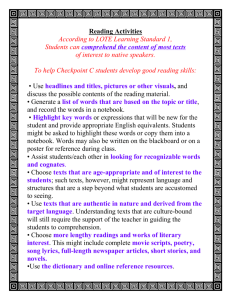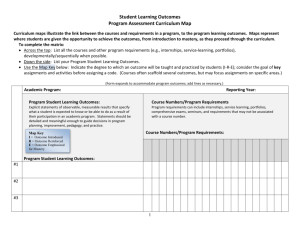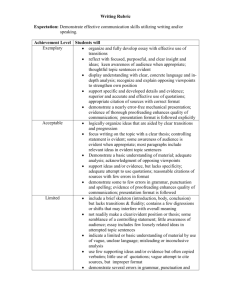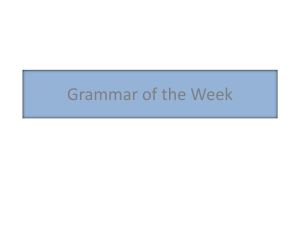DE ANZA COLLEGE
advertisement
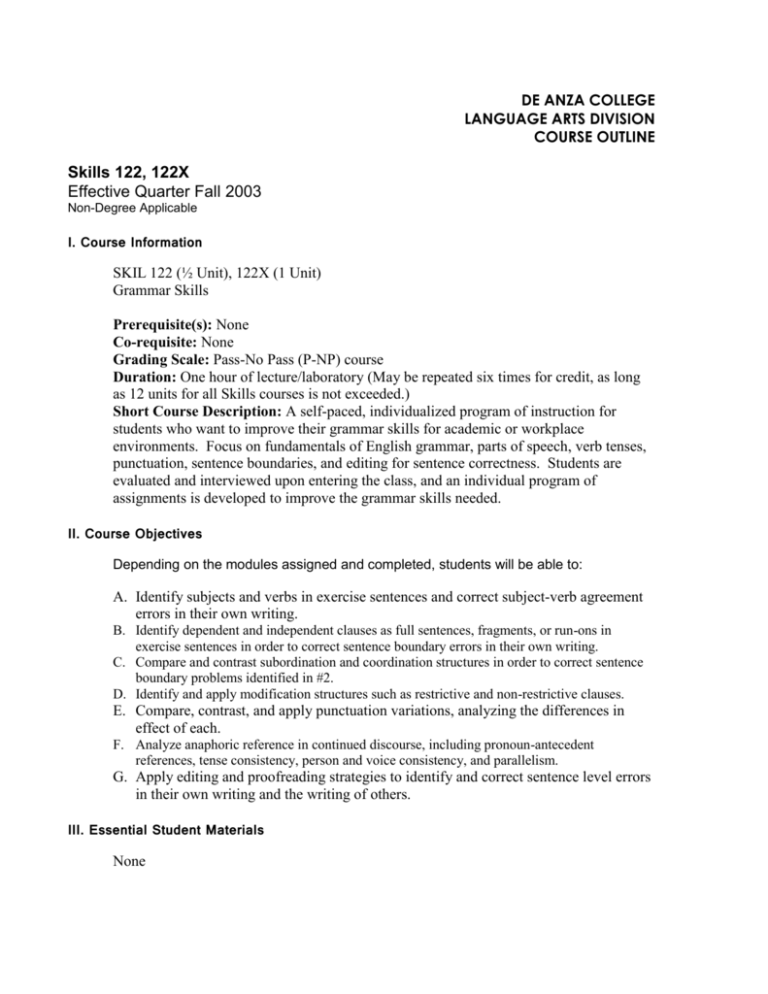
DE ANZA COLLEGE LANGUAGE ARTS DIVISION COURSE OUTLINE Skills 122, 122X Effective Quarter Fall 2003 Non-Degree Applicable I. Course Information SKIL 122 (½ Unit), 122X (1 Unit) Grammar Skills Prerequisite(s): None Co-requisite: None Grading Scale: Pass-No Pass (P-NP) course Duration: One hour of lecture/laboratory (May be repeated six times for credit, as long as 12 units for all Skills courses is not exceeded.) Short Course Description: A self-paced, individualized program of instruction for students who want to improve their grammar skills for academic or workplace environments. Focus on fundamentals of English grammar, parts of speech, verb tenses, punctuation, sentence boundaries, and editing for sentence correctness. Students are evaluated and interviewed upon entering the class, and an individual program of assignments is developed to improve the grammar skills needed. II. Course Objectives Depending on the modules assigned and completed, students will be able to: A. Identify subjects and verbs in exercise sentences and correct subject-verb agreement errors in their own writing. B. Identify dependent and independent clauses as full sentences, fragments, or run-ons in exercise sentences in order to correct sentence boundary errors in their own writing. C. Compare and contrast subordination and coordination structures in order to correct sentence boundary problems identified in #2. D. Identify and apply modification structures such as restrictive and non-restrictive clauses. E. Compare, contrast, and apply punctuation variations, analyzing the differences in effect of each. F. Analyze anaphoric reference in continued discourse, including pronoun-antecedent references, tense consistency, person and voice consistency, and parallelism. G. Apply editing and proofreading strategies to identify and correct sentence level errors in their own writing and the writing of others. III. Essential Student Materials None IV. Essential College Facilities Academic Skills Center equipped with collection of texts, videos, and computer-based instructional materials, a quiet work area, a group workshop area, several computers and a printer for instructor-supervised demonstration of educational software. V. Expanded Description: Content and Form After completing a diagnostic test and initial instructor conference, each student will be assigned to complete Module One plus one or more of the modules listed below. The modules are not sequential, but can be combined in any order depending on the students' ability and goals. A minimum of two modules will be completed for each .5 unit of credit. Small group workshops (one hour) for each module are offered at various times throughout the quarter. Take-home journal assignments required for each module. Diagnostic test A. Module One: Understanding the Sentence 1. Understanding the basic structure of the sentence 2. Finding the complete subject a. Checkpoint Journal Assignment 3. Finding the complete verb a. Mastery Proofreading Assignment B. Module Two: Solving Problems with Verbs 1. Subject-Verb Agreement 2. Verb Tenses a. Checkpoint Journal Assignment 3. Tense Shifts a. Mastery Proofreading Assignment C. Module Three: Solving Problems with Sentence Boundaries 1. Independent and dependent clauses 2. Coordination methods 3. Subordination methods a. Checkpoint Journal Assignment 4. Run-on sentences 5. Fragments a. Mastery Proofreading Assignment D. Module Four: Solving Problems with Pronouns 1. Functions of Pronouns a. Checkpoint Journal Assignment 2. Pronoun-Antecedent Agreement a. Mastery Proofreading Assignment E. Module Five: Solving Problems with Modifiers and Prepositions 1. Adjectives, adverbs, and articles a. Checkpoint Journal Assignment 2. Prepositions a. Mastery Proofreading Assignment F. Module Six: Punctuation 1. Sentence endings 2. Commas a. Checkpoint Journal Assignment 3. Capitalization 4. Quotations a. Mastery Proofreading Assignment G. Module Seven: Improving Sentences 1. Concrete and concise language 2. Parallel construction a. Checkpoint Journal Assignment 3. Passive Voice 4. Sentence variety and emphasis a. Mastery Proofreading Assignment Final Assignment: Integration and Summary of Modules Studied. VI. Assignments For each student, instructors will complete an Assignment Sheet indicating the modules assigned. For each module, instructors will specify materials (including texts and/or software) and assignments to match the student's ability level. A. B. C. D. E. Diagnostic test and instructor conference to determine start level and modules to be assigned. Exercises and writing (including texts and/or software) for each module. Checkpoint journal assignments for each module, to be assigned by an instructor. Follow up conferences with instructors to evaluate progress. Mastery writing and proofreading assignment for each module, to be assigned by an instructor. F. Take-home journal assignments drawn from students’ areas of interest. G. Final assignment integrating material from modules studied H. Small group workshops (one hour) for each module, offered at various times throughout the quarter. VII. Methods of Evaluating Objectives A. Completion of diagnostic test and evaluation by Skills instructional staff to direct students to complete lab modules appropriate to each student's individual needs. B. Completion and evaluation by Skills instructional staff of lab modules, including checkpoint, mastery, and take-home journal assignments. C. Time log showing at least twelve hours of work in the Skills Center. D. Time log showing participation in workshops and individual conferences with Skills instructors. VIII. Texts and Supporting References (Texts for each module will be assigned by instructors to match students' ability levels. Texts listed below cover material from various modules.) A. B. Required Texts: None Supporting References: BOOKS Azar, Betty Schrampfer Chartbook: A Reference Grammar, 3rd Edition. Prentice Hall Regents, 2000. Bell, George E. Writing Effective Sentences. Allyn and Bacon, 1993. Building Basic Skills in Writing. Contemporary Books, Inc., 1988. Clouse, Barbara Fine. Jumpstart: A Workbook for Writers, 2nd Edition. McGraw-Hill Inc., 2002. Langan, John. Sentence Skills with Readings. McGraw Hill, 1997. Neuburger, Thomas R. Foundations. Houghton Mifflin Company, 1989. Olin, Walter E. Writing that Works, 2nd Edition. St. Martin's Press, Inc., 1998 Raimes, Ann. Grammar Troublespots, 2nd Edition. St. Martin's Press, Inc., 1998. Smith, R. Kent & Goldstein, Janet M. English Brushup. Townsend Press, Inc., 1993. Smoke, Trudy. A Writer's Workbook. St. Martin's Press, Inc., 1992. Troyka, Lynn Qjuitman & Gordon, Emily R. Simon & Schuster: Workbook for Writers. Prentice-Hall, Inc., 1996. Tyner, Thomas E. College Writing Basics. Wadsworth Publishing Company, 1996 Wellington, Pat. Shaping Up Your English. Allyn and Bacon, 1995. Winkler, Anthony C. & McCuen, JoRay. Writing Talk, 2nd Edition. Prentice-Hall, Inc., 2000. SOFTWARE Perfect Copy Classic. Logicus Incorporated, 1992. English Microlab. Houghton Mifflin Company, 1996. Various software, handouts, and web-based resources as assigned.

